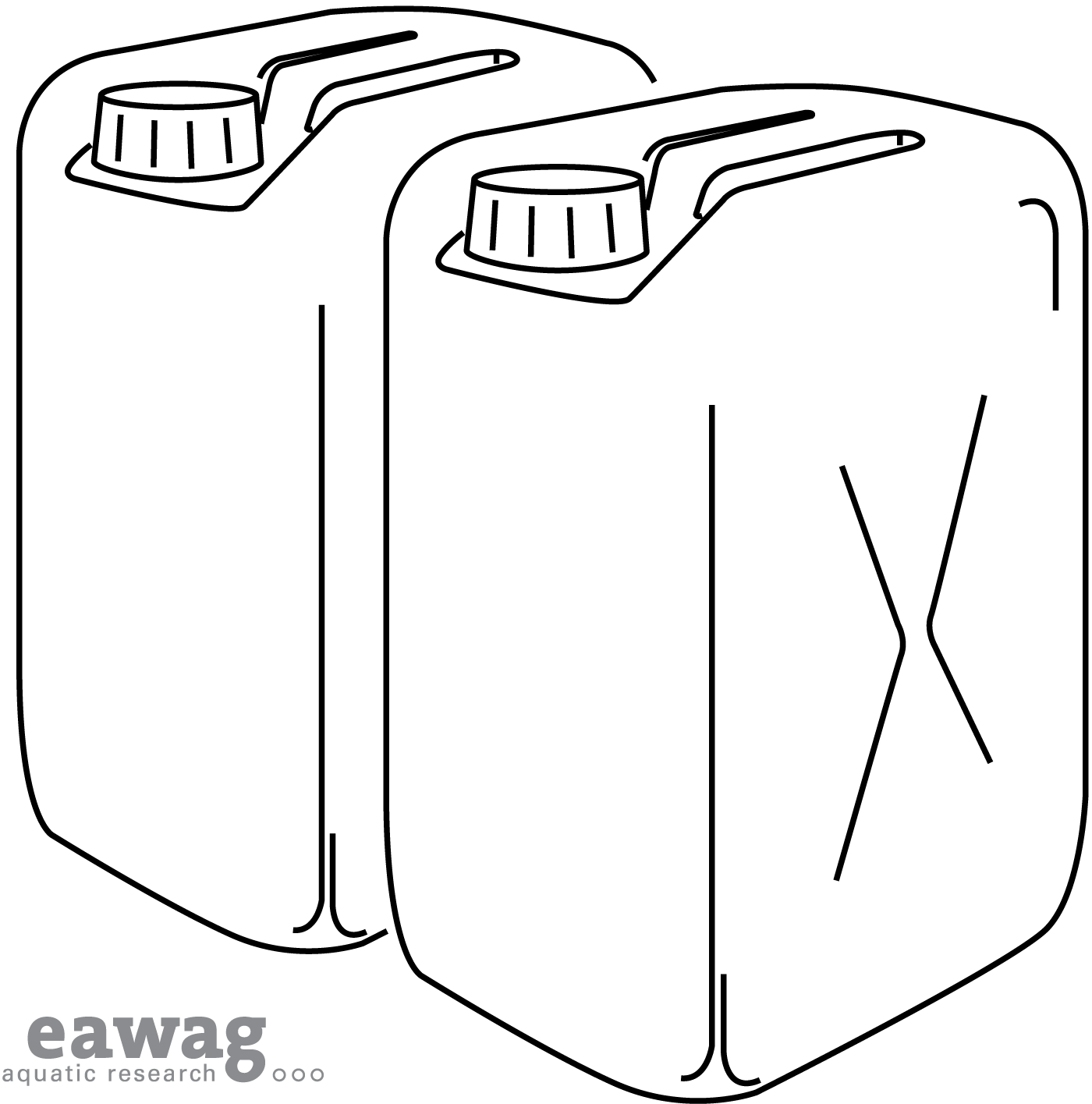Difference between revisions of "Jerrycan - tank"
| Line 27: | Line 27: | ||
|} | |} | ||
| + | <br> | ||
---- | ---- | ||
| + | <br> | ||
[[Image:Icon_jerrycan_tank.png |right|80px]] | [[Image:Icon_jerrycan_tank.png |right|80px]] | ||
Revision as of 07:12, 26 September 2013
|
|||||||||||||||||||||||||||
Jerrycans are light, plastic containers that can be easily carried by one person and are readily available. When sealed, they can be used to store or transport urine easily and without spills. In case separated urine cannot be used near the point of production, it can be transported in a Jerrycan or tank to a central collection/storage facility or to agricultural land for application.
On average, a person generates 1.5L of urine a day although this quantity may very significantly depending on the climate and fluid consumption. A family of 5 can be expected to fill a 20L Jerrycan with urine in approximately two days. The urine can then be either stored on site or transported immediately.
For compounds or communities that all have urine diverting systems, it may be more appropriate to have a larger, semi-centralized storage tank that can be transported by other means. Where urine-diversion systems are common, a micro-enterprise may specialize in the collection and transport of Jerrycans using a bicycle, wagon or donkey and cart.
| Advantages | Disadvantages |
|---|---|
| - Very low capital and operating costs. - Potential for local job creation and income generation. |
- Heavy to carry. - Spills may happen. |
Contents
Adequacy
A well-sealed Jerrycan is an effective way of transporting urine short distances. It is inexpensive, easy to clean and re-useable. This type of transport is only appropriate for areas where the points of generation and use (i.e. home and field) are close together, otherwise a more formalized collection and distribution system is necessary.
Jerrycans can be used in cold environments (where urine freezes) as long as they are not completely filled. Stored frozen urine can be then used in warmer months when it is needed for agriculture.
Because of safety concerns and difficulty with transport, no other liquids (blackwater or greywater) should be transported in Jerrycans
Health Aspects/Acceptance
There should not be any health risks to those carrying a Jerrycan as urine is generally sterile and the Jerrycans seal well. While carrying a Jerrycan may not be the most pleasant activity, it is likely more convenient and less costly emptying a pit.
In some locations, urine has an economic value and it may be collected from the household for free. Families who invest the time to transport and use their own urine may be rewarded with increased agricultural production improving the families health and/or increasing their income.
Upgrading
If urine is viewed as a commodity, locally run businesses may collect and transport it for free or for a small fee.
Maintenance
To minimize bacterial growth, sludge accumulation and unpleasant odours, Jerrycans should be washed frequently.
References
- Austin, A. and Duncker L. (2002). Urine-diversion. Ecological Sanitation Systems in South Africa. CSIR, Pretoria, South Africa.
- GTZ (2005). Technical data sheets for ecosan components- 01 Urine Diversion-Piping and Storage. GTZ, Germany.
- Morgan, P. (2007). Toilets that make compost. Stockholm Environment Institute, Stockholm, Sweden.
- Morgan, P. (2004). An Ecological Approach to Sanitation in Africa: A Compilation of Experiences. Aquamor, Harare, Zimbabwe. Chapter 10: The usefulness of Urine.
- NWP (2006). Smart Sanitation Solutions. Examples of innovative, low-cost technologies for toilets, collection, transportation, treatment and use of sanitation products. Netherlands Water Partnership, Netherlands.
- Schonning, C. and Stenstrom, TA. (2004). Guidelines for the Safe Use of Urine and Faeces in Ecological Sanitation Systems-Report 2004-1. EcosanRes, Stockholm Environment Institute, Stockholm, Sweden.
- Winblad, U. and Simpson-Herbert, M. (eds.) (2004). Ecological Sanitation – revised and enlarged edition. Stockholm Environment Institute, Stockholm, Sweden.
- WHO (2006). Guidelines for the safe use of wastewater, Excreta and Greywater- Volume 4: Excreta and Greywater use in agriculture. WHO, Geneva.
Acknowledgements
The material on this page was adapted from:
Elizabeth Tilley, Lukas Ulrich, Christoph Lüthi, Philippe Reymond and Christian Zurbrügg (2014). Compendium of Sanitation Systems and Technologies, published by Sandec, the Department of Water and Sanitation in Developing Countries of Eawag, the Swiss Federal Institute of Aquatic Science and Technology, Dübendorf, Switzerland.
The 2nd edition publication is available in English. French and Spanish are yet to come.


